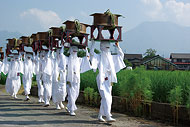Highlights of Aso Geopark
Aso Volcano is rich in diverse and awe-inspiring topography and geology, including one of the world's largest calderas and many smaller volcanos. People have made their homes in this natural environment for tens of thousands of years, developing a unique culture and landscape. Aso Geopark encompasses a large area including the caldera and its surroundings, with many geosites throughout highlighting the volcanic topography and geology.
>> 1.Traces of volcanic eruptions on the caldera
2.An encounter with daily life in Aso
Grasslands and daily life

Vast grasslands cover the slopes of the central cone group and the outer side of the caldera rim. This impressive landscape is not an untouched wilderness but rather the result of over 1,000 years of human management including grazing, grass harvesting, and controlled burning. An example of "secondary nature" created through coexistence between humans and the natural environment, the grasslands are a product of Aso's history.
In particular, the controlled burns that take place early each spring have played a crucial role in preventing the growth of forest on the grasslands. Burning also reduces the risk of wildfire and flooding in heavy rains by removing large debris that can block rivers or catch fire. By doing so it contributes to water and soil conservation.

Scholars know that this grassland landscape has existed for at least 1,000 years because the Chronicles of Japan, and ancient text, describes "plains that extend far and wide into the distance." The Engishiki, a tenth-century text, also mentions "pastures at Futaenotouge Mountain Pass," providing evidence that grazing has been practiced in Aso since the Heian Era (794-1185).
Volcanic activity and religious belief

Nakadake Crater has been an object of faith since ancient times, when people deeply revered the natural world. Because they believed Aso Volcano was the dwelling place of the gods, volcanic activity and other irregular events signified the wrath of the gods, which they believed would be followed by famine or epidemics. For this reason any irregularities in volcanic activity were reported to the central government, and Aso Shrine, whose primary deity is the volcano god Takeiwatatsunomikoto, was worshiped at the national level. The shrine's history reaches back approximately 2,300 years, and the Aso family who manages it to this day counts 91 generations.
The mountain was also an object of worship for the ascetic followers of ancient Saigandenji Temple (Tendaishu sect of Buddhism), which flourished in the middle ages. Local people prayed at the mouth of the crater as well. These forms of worship continue as a religious tradition to this day; together they are referred to as "kazan-shinko," or volcanic faiths.

- Aso Shrine
- Twelve deities are worshipped at Aso Shrine, foremost among them Takeiwatatsunomikoto, who is enshrined in the main pavilion. The Shrine has over 500 sub-shrines throughout Japan. Aso-sanjo Shrine, located at the mountaintop Aso-sanjo Hiroba, is a branch of the same shrine. The traditional agricultural rites that are still practiced at the temple have been designated as an Important Intangible Folk Culture Asset by the national government.
Abundant hot and cold springs
As in many volcanic regions, abundant springs well from the ground in Aso Caldera and its surrounds. However, although there are over 1,500 springs in the region, the complicated mechanisms governing them are not fully understood. Key spring-related geosites include the Cluster of Springs in Minami-Aso District, the Outer Rim Spring Group, and Miyaji and Yakuinbaru District Springs.
The Aso area has a very large number of hot springs as well. Although the water is heated by volcanic activity, the amount of magmatic substances in Aso's hot springs is low and the proportion of groundwater filtered through layers of earth is high. The springs are influenced not only by Aso Volcano, but also by Kuju Volcano, located just northeast of Aso.

- Yamabuki Spring
- This spring located between Aso and Kuju gushes 30 tons of water per minute, as does Ikeyama Spring, another geosite. It has been selected as one of Kumamoto's top 100 aquatic resources.

- Jigoku Onsen
- These springs, whose name means "Hell's Hot Springs," are located approximately 700 m above sea level on the southwestern slopes of the central cone group. Set inside an explosion crater caused by the eruption of Mt. Yominesan, the Jigoku Onsen spas have thrived since the Edo era (1603-1868).
